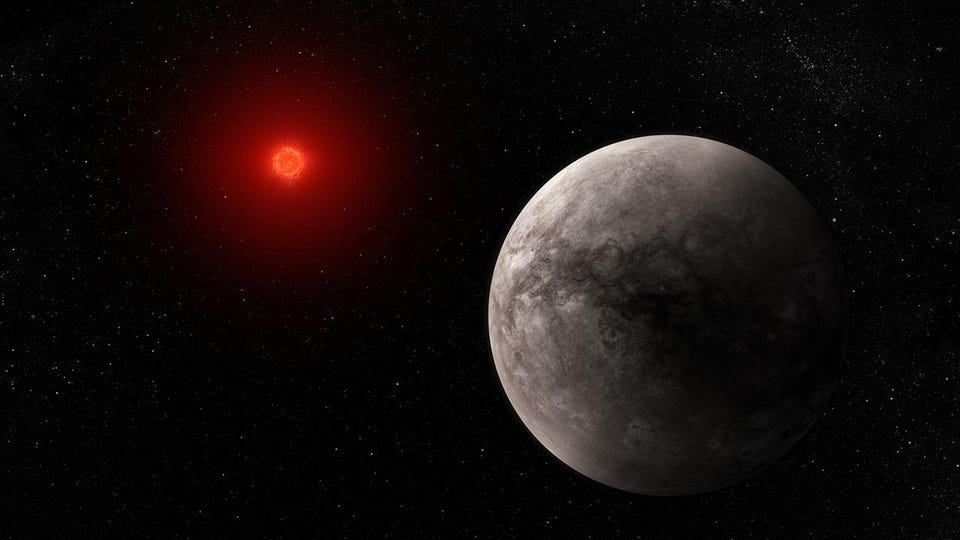Forbes Innovation Science NASA’s Webb Telescope Just Took A Big Step Forward In The Search For Another Earth Eric Mack Contributor Opinions expressed by Forbes Contributors are their own. I cover science and innovation and products and policies they create. Following Mar 27, 2023, 12:26pm EDT | Press play to listen to this article! Got it! Share to Facebook Share to Twitter Share to Linkedin This illustration shows what the hot rocky exoplanet TRAPPIST-1 b could look like.
NASA, ESA, CSA, Joseph Olmsted (STScI) Astronomers using the most advanced observatory in NASA’s arsenal of space-gazing toys reported a big first on Monday: the James Webb Space Telescope was able to detect the light from a small, rocky exoplanet similar to our own but orbiting another star some 40 light years away. To be clear, this is far from the first time our observatories have led to the discovery of exoplanets beyond our solar system. Thousands have been cataloged over the past few decades.
But most are discovered by measuring slight differences in the light from distant stars that tell us either a planet is passing in front of or gently tugging on its home sun. Astronomers have also directly observed the light from other exoplanets as well, but they tend to be much larger gas giant worlds. The Webb team reports this is the first detection of light directly emitted by an Earth-like exoplanet and that’s a big deal because this type of measurement not only tells us the distant world is there, but it can also provide details about the planet and its potential for hosting alien life.
Infographic titled, “Rocky Exoplanet TRAPPIST-1 b Dayside Temperature Comparison, MIRI F1500W . . .
[+] showing five planets plotted along a horizontal temperature scale: Earth, TRAPPIST-1 b, Mercury, and two different models of TRAPPIST-1 b. NASA, ESA, CSA The specific planet observed in this case is Trappist-1b, which orbits closest in to the dwarf star Trappist-1. You may recall the Trappist-1 system excited astronomers when it was first found a number of years ago because it appeared to be circled by multiple rocky, Earth-sized planets in the habitable zone.
MORE FOR YOU The ‘Backsies’ Billionaire: Texan Builds Second Fortune From Wreckage Of Real Estate Empire He’d Sold 2023 Layoff Tracker: Disney Starts Cutting 7,000 Employees Ruling In Favor Of Washington State Capital Gains Tax, A Big Win For Progressives, Is An Outlier In The Overall Trend “These observations really take advantage of Webb’s mid-infrared capability,” said Thomas Greene , an astrophysicist at NASA’s Ames Research Center and lead author on the study published today in the journal Nature. “No previous telescopes have had the sensitivity to measure such dim mid-infrared light. ” MORE FROM FORBES TRAPPIST-1’s Planets May Have Shockingly Similar Compositions, Says NASA By Bruce Dorminey The international team of researchers was able to use the infrared data to measure the heat from the planet, determining that the temperature on the side of the planet facing its sun is about 450 degrees Fahrenheit, which also suggests this is a world with no significant atmosphere.
That’s quite a blow for the chances any form of life as we know it can survive on Trappist-1b. Like many small, rocky planets orbiting close-in around red dwarf stars like Trappist-1, this world is expected to be tidally locked just like the moon is to Earth. That means the planet does not rotate on its axis and one side is always facing the star.
This isn’t a recipe for the most habitable climate, but there is some research to support the idea life can exist on the “terminator” of such planets, or the area near the transition from the dayside to nightside. So there could theoretically still be some hope of very hardy aliens on Trappist-1b. But there is another hurdle to life for worlds around this type of star: they have a really bad habit of giving off lots of solar flares compared to larger stars like our own sun.
These blasts could be regularly sterilizing the worlds of the Trappist-1 system with heavy doses of stellar radiation. “There are ten times as many of these stars in the Milky Way as there are stars like the Sun, and they are twice as likely to have rocky planets as stars like the Sun,” explained Greene. “But they are also very active — they are very bright when they’re young, and they give off flares and X-rays that can wipe out an atmosphere.
” Regardless of the chances of finding E. T. circling Trappist-1, scientists say the system makes for a great place to practice looking.
“It’s easier to characterize terrestrial planets around smaller, cooler stars,” added co-author Elsa Ducrot from the French Alternative Energies and Atomic Energy Commission (CEA). “If we want to understand habitability around M stars, the TRAPPIST-1 system is a great laboratory. These are the best targets we have for looking at the atmospheres of rocky planets.
” Follow me on Twitter or LinkedIn . Check out my website . Eric Mack Editorial Standards Print Reprints & Permissions.
From: forbes
URL: https://www.forbes.com/sites/ericmack/2023/03/27/nasas-webb-telescope-just-took-a-big-step-forward-in-the-search-for-another-earth/



